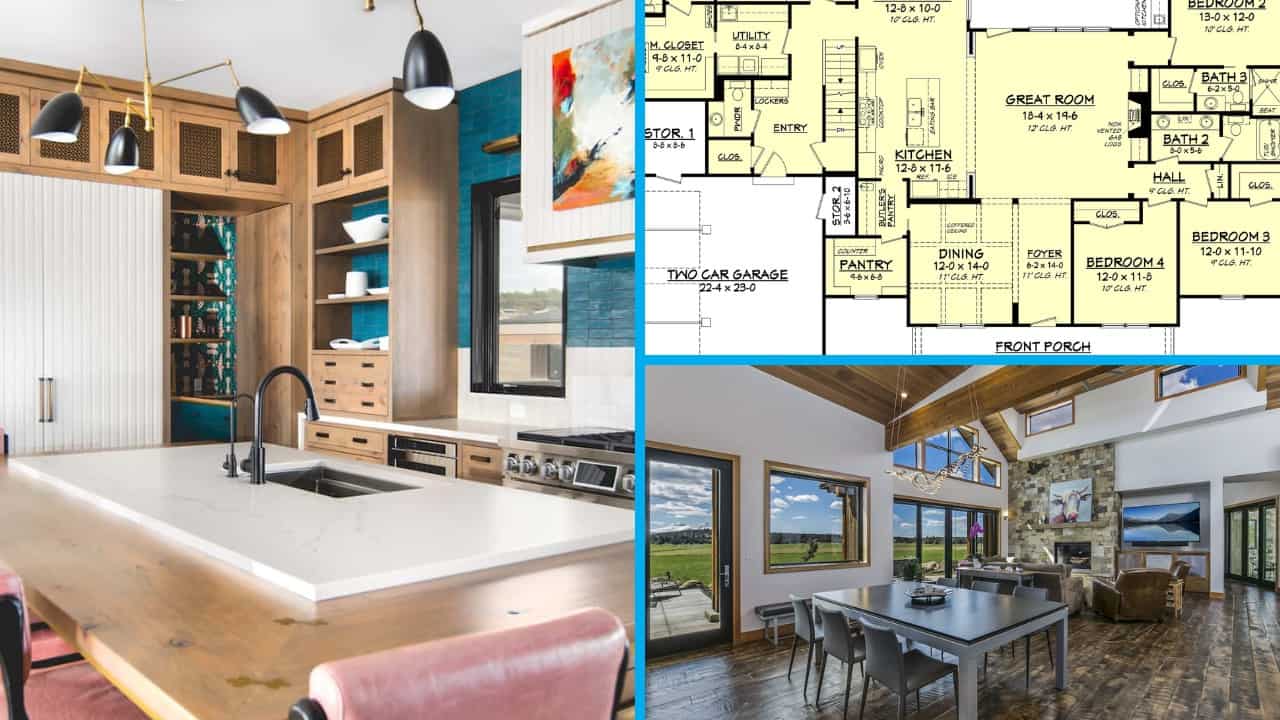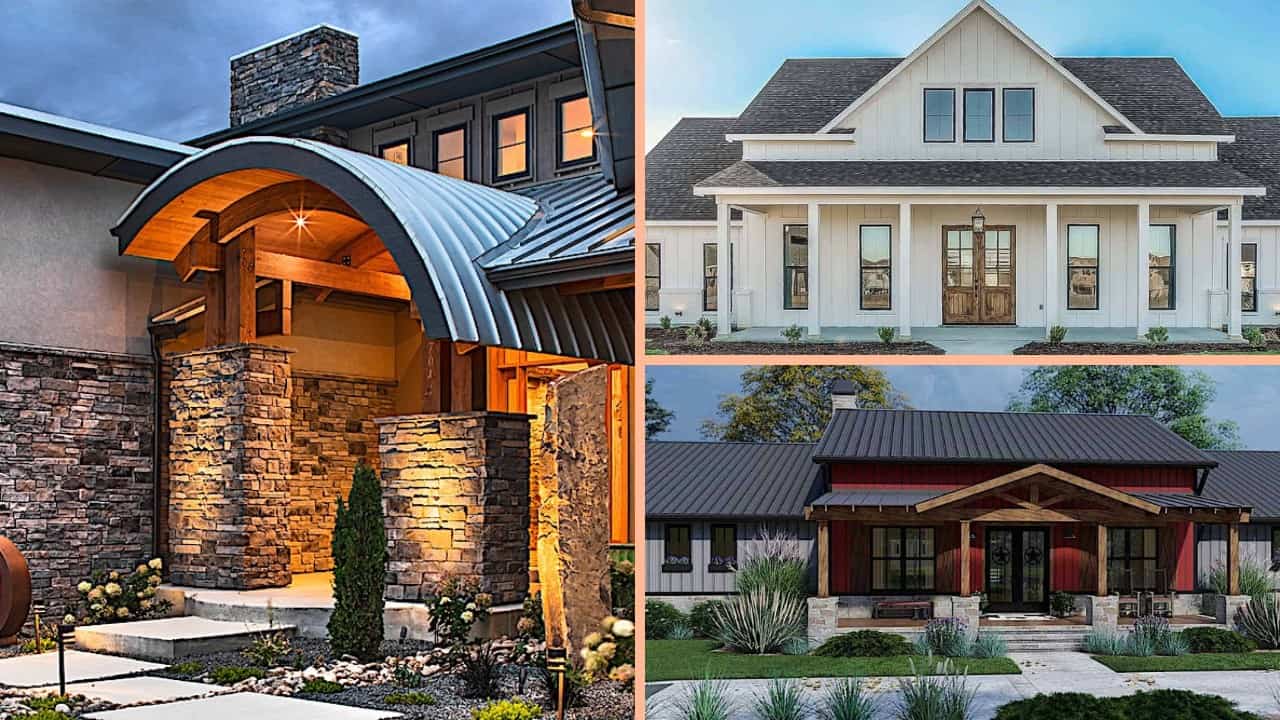Neoclassical Homes & Architecture - Symmetry & Simplicity
By Rexy Legaspi | Updated April 04, 2023
All About Neoclassical Style Homes
Inspired by the art and culture of Ancient Greece and Rome, the Neoclassical style emerged in the mid-18th century as a reaction to the flamboyance and decorative frivolity of the Baroque and Rococo styles. Neoclassical architecture – in its purest form – is derived from classical Greek and Roman architecture as well as the principles of French architect Claude Perrault, who is renowned for his participation in the design of the East Facade of the Louvre, and the Italian architect Andrea Palladio, who emphasized symmetry, order, and harmony with the site in his designs.
Let’s explore the Neoclassical style and its influence on the design of public buildings and modern residences – and on America’s Founding Fathers.
This stately 2-story, 4,378-square-foot Country home displays its Neoclassical touches – from its symmetrical perfection, to the full-height colonnaded portico with the pediment, the elaborate doorway, and evenly spaced windows. The luxurious home features 4 bedrooms, 4.5 baths , and an open floor plan, rear porch, patio, study, den, game room, main floor laundry, and other amenities (Plan #140-1008).
What is Neoclassical Style Architecture?
Designed with the perfectly proportioned buildings in mind, Neoclassical architecture includes simple geometric forms, symmetry, and balance, which presented a dramatic contrast to the Baroque’s and Rococo’s style’s elaborate ornamentation, asymmetry, curves, moldings, and serpentine lines. The style, with its uncluttered appearance and grandeur of scale, often features full-height front porches topped by a front facing pediment; massive columns with classical Corinthian, Doric, or Ionic capitals; and flat roof lines enhanced by a dome or tower.
The style features these distinct elements:
1. Symmetrical purity and balance that reiterate the concepts of simplicity and order.
2. An even number of tall classical columns that support a full-height front porch. The columns are generally Doric in style, but Ionic and Corinthian styles can also figure in.
3. Elaborate doorways with triangular pediments that serve as decorative touches.
4. Evenly spaced windows across the front facade and flanked by shutters.
5. Flat roofs with a center dome.
This architecture was eagerly adopted by municipal building architects, the wealthy in their mansions and plantations, and many presidents over the years.
A magnificent 2-story, 5,730-square-foot European-inspired manor checks off a number of the elements of Neoclassical architecture. Let’s start with the clean lines, symmetry, and balance – from the number of huge columns that support the full-height front porch to the evenly spaced windows across the front façade – and the pediment, dome, and elaborate doorway. The luxury home has 3 bedrooms, 4 baths, 2 half baths, and a spectacular spiral staircase, Grand Room with a fireplace, library, main floor master suite, family room, and in-law suite (Plan #106-1154).
Influences Today
Today, it’s not just U.S. presidents, plantation owners, and the wealthy who have designed Neoclassical homes – or incorporated elements of the style in their residences.
Since its beginnings in early America, it has captivated diverse groups across many geographical and economic areas. And that appeal is alive and well in the 21st century.
The fascination for symmetrical shape and balance, huge columns, elaborate doorways, the triangular pediment, and full height porches continues to this day. While not every element or distinct feature of Neoclassical architecture may be present in a residence, there may be enough to give it character and curb appeal.
Although we may associate neoclassicism primarily with grand public buildings, the approach has also shaped the way we build private homes. Here’s a look at several house styles that have incorporated these features in their designs.
Examples of Neoclassical House Plans
Two-Story Colonial
Symmetry and balance are exhibited in the amazing two-story, five-bedroom Colonial style home shown here. A pediment is atop the full-height double portico supported by tall columns, and there are evenly spaced windows across the front facade to complete the Neoclassical accents. The house plan definitely exudes the feeling of a historic home.
One-Story Colonial
You don’t have to go all formal to achieve the effect of the Neoclassical style. Take the one-story, three-bedroom Colonial home shown above with the covered front porch and matching number of columns across the exterior facade that frame the wood and glass door. There’s symmetry in the windows with the decorative shutters. Even the rockers and planters on the porch are balanced in numbers and positioning.
1.5-Story French Country Plan
The 1.5-story, three bedroom, two-bath French Country home we focus on here will stop you in your tracks. There are just so many attractive features – clean lines, soft paint tones on the exterior, a pair of dormers, a covered front porch with tall columns, a pair of windows with shutters, and planters and sconces framing the wood and glass-paned door.
One-Story Craftsman
The attractive one-story, three-bedroom Craftsman home above combines classical details – columns on stone pedestals, windows that flank the front door – with relaxed country accents to achieve a comfortable, homey feel.
Southern Plantation / Colonial
Take one look at the covered front porch of the Southern Colonial home you see above, and it immediately feels like a grand home, not the least because of the classical styling. The two-story columns on the porch and the pediment up top are giveaways of Neoclassical tradition so prevalent in large Southern homes. Meanwhile, everything else has a comfortable home-like quality. The study, dining room, living room, and master bedroom all make the main floor into a comfortable family gathering place. The second floor also brings that feeling with a fun game room, TV area, and Juliet balcony
History of Neoclassical Architecture around the World
The Neoclassical style, which includes Roman and Greek revivals, was a loud and clear expression of a return to order and rationality. As it thrived throughout Europe, almost every important city exhibited memorable examples of Neoclassical houses and architecture. From Rome to London, Paris, Berlin, and St. Petersburg, major architects were designing historic landmarks, lavish mansions, and estates in thi style.
England
Early neoclassical architecture in England (1640-1750) includes St. Paul’s Cathedral, the Royal Observatory, and the Royal Chelsea Hospital – all designed by Sir Christopher Wren. Other architects in the early period were William Kent (Charing Cross) and Robert Adam (Theatre Royal London).

One of the masterpieces of Sir Christopher Wren in Neoclassical architecture is St. Paul’s Cathedral in London. Constructed in 1675, the Cathedral was part of a major rebuilding project in England after the Great Fire. Its West Front shows the colonnaded double portico, the triangular pediment atop the portico and the bell towers. Its dome (slightly visible behind the pediment) is among the tallest in the world at 365 feet. It dominated the London skyline for more than 300 years (photo credit: St. Paul’s Cathedral from West by Steve Cadman under license CC BY-SA 2.0).
England, which never really showed an inclination toward the Baroque style, used Neoclassical elements in its public buildings, museums, theaters, hotels, banks, and post offices. But the British Royalty had other ideas – and commissioned John Nash (1752-1835), one of the country’s greatest architects, to redesign city blocks and parks, and other important areas of London. His best-known works include Buckingham Palace, the Marble Arch, Royal Pavilion, and Brighton. In tandem with property developer James Burton and his son Decimus, Nash designed Regent Street, Regent’s Park and its terraces, and Carlton House Terrace.
Among Nash’s contemporaries was Sir John Sloane (1753-1837), who designed the Bank of England, Pitshanger Manor, and the Dulwich Picture Gallery. Another notable English Neoclassical architect – Sir Robert Smirke (1780-1867) – designed the British Museum, the General Post Office, Covent Garden Theatre, and Eastnor Castle.

What started as Buckingham House in 1761 for George III and Queen Charlotte became Buckingham Palace during the reign of King George IV. Initially, the new king who ascended the throne in 1820 wanted to reconstruct the house into a pied-à-terre. At the end of 1826, George IV decided to transform the house into a palace – designed by John Nash in the French-Neoclassical style. Neither Nash nor George IV saw the completion of the palace. In 1837, Queen Victoria took up residence at Buckingham Palace, the first sovereign to live there (photo credit: Buckingham Palace, London - April 2009 by Diliff under license CC BY-SA 3.0).
Neoclassicism in France
With a number of French architects trained at the French Academy in Rome, this style found a second home in France. Key elements of the style became part of the country’s architecture design during the time of Louis XVI and the Napoleonic Empire. Experimental architects used it in many civic buildings, and French aristocrats incorporated the styles features in their mansions – and added grottos, lush gardens, fountains, and landscaped courtyards.
Among the most renowned French architects of the period were Jacques Germain Soufflot (1713-1789) – responsible for the Parisian Pantheon, which started as the Church of Sainte-Genevieve, the patron saint of Paris. Located in the historic Latin Quarter, the Church was renamed the Pantheon during the French Revolution and became a mausoleum for famous French figures like Voltaire, Rousseau, Marie Curie, Alexandre Dumas, Victor Hugo, and others. Some of its classical elements include a massive facade supported by tall Corinthian columns, a triangular pediment, and a high dome.

In addition to Soufflot, France’s exponents of Neoclassical architecture were:
Claude-Nicolas Ledoux (1736 –1806), who not only designed buildings but also was involved in town planning and whose works were funded by the French monarchy. Ledoux is best known for the Cathedral of Saint-Germaine, Theatre de Besancon, and the Chateau de Benouville. His most ambitious work was the uncompleted Tho, a large and grand vision for a new ideal city. Much of Ledoux’s work was destroyed in the nineteenth century.
Jean Chalgrin (1739-1811), who is immortalized for his best known work – Paris’s Arc de Triomphe. Chalgrin also designed hotels, including the Hotel Saint-Florentin, which was renamed a number of times prior to its demolition in 1842. When it was called the Hotel de Langeac, it was a residence for Thomas Jefferson – from 1785 to 1789 when he was assigned as a Minister to France – as well as Benjamin Franklin and John Adams.

Commissioned by Napoleon Bonaparte to celebrate the achievements of the French armies, the triumphal arch – Arc de Triomphe – was designed in the Neoclassical style by Jean Francois Therese Chalgrin. Standing at the center of the Place Charles de Gaulle in Paris, the arch is 164 ft. tall and 148 ft. wide. On the facades of the arch’s four massive pedestals decorative high-relief sculptures celebrating military victories of the Revolution and the First Empire (photo credit: Arc de Triomphe, 23 February 2016 by Thomas Bresson under license CC BY-SA 4.0).
United States
While Neoclassical architecture was popular throughout France, it actually flourished and took deeper roots in the young American republic, and played a major role in national history. Across the United States – and most commonly in the Northeast and the South – there are impressive examples of this type of architecture, ranging from civic buildings, courthouses, and churches to schools and mansions.
After the American War of Independence against Great Britain (1775-1783), civic and public buildings throughout the new country adopted the classical ideals of symmetry and order. Founding fathers like Thomas Jefferson, also an important architect, viewed Neoclassical style as a link between the new republic’s ideas of government and the ideals of democracy expressed by ancient Greece and Rome.
Jefferson, the third President of the U.S., wore many hats. He wrote the original draft of the Declaration of Independence, served as a Minister to France, and was a respected architect. Monticello, his home in Charlottesville (Virginia), one of his first attempts at the Neoclassical style, has been described as an “essay in architecture.” It took more than 40 years to complete this masterpiece.
In 1769, Jefferson started the construction of the first version of Monticello – an eight-room home he designed according to the principles of Andrea Palladio. With all the redesign and rebuilding over the years, Monticello expanded into a 21-room mansion with an elevated main floor centered on a pavilion with a colonnaded portico and a low dome.

The perfect expression of the Neoclassical style is Monticello (seen from rear), the plantation home of Thomas Jefferson, the third President of the U.S. and author of the Declaration of Independence. Jefferson borrowed from Andrea Palladio in designing this magnificent home (photo credit: Thomas Jefferson’s Monticello (cropped) by Martin Falbisoner under license CC BY-SA 3.0).
In 1786, Jefferson conceived the design for one his most acclaimed structures – the Virginia State Capitol building in Richmond. It was designed and modeled after the Maison Carree, a well-preserved Roman temple built in the 1st century B.C.E. in Nimes, Southern France.
Not quite finished with his architectural accomplishments, Jefferson began the construction of Poplar Forest – his home away from Monticello in 1806. Poplar Forest was a 4,800-acre plantation acquired through his marriage to Martha Wayles Skelton. The octagon-shaped house has been called the “purest of his Neoclassical architectural masterpieces.” The one-story home is set on a high basement and has most of the features of Jeffersonian architecture: symmetry, classic porticoes with pediments and white columns, red bricks, and polished floors.
Between 1814 and 1826, Jefferson designed and supervised the construction of the university of his dream – the University of Virginia at Charlottesville.
Jefferson was certainly not the only post-American Revolution architect in the country to build memorable Neoclassical style structures. William Thornton (1759-1828), Benjamin Latrobe (1764-1820) and Charles Bulfinch (1763-1844) designed the U.S. Capitol Building, which remains as one of the most recognizable and iconic examples of the style.


Top: The Virginia State Capitol – seen here as it was in 1865 – was designed after the Maison Carree, an ancient Roman temple in Southern France. The perfectly proportioned rows of tall columns, the simple geometric form, and the order and balance of the whole structure embody the elements of Roman architecture (photo credit: Public Domain). Bottom: The Virginia State Capitol as seen in 2005 (photo credit: Virginia State Capitol Late Morning by Martin Falbisoner under license CC BY-SA 3.0)

Built on a 4,800-acre plantation, Poplar Forest, the “home away from home” of President Thomas Jefferson, is a 1-story octagon-shape home set on a high basement. Jefferson liked octagonal shapes and rooms because they allow a lot of natural light to filter inside a home (photo credit: Poplar Forest by Warfieldian under CC BY-SA 3.0).
More on This Style & the American Presidents
As montioned above, perhaps one of the most significant proponents of Neoclassical architecture was Thomas Jefferson – not only in his belief in the ideals of justice and democracy that the style symbolized for the young American Republic, but also in his creative capacity as an architect. When he became the third President of the United States and moved to the White House, for example, he and Benjamin Latrobe added low colonnades on each wing that concealed the stables and storage spaces.


Jefferson was not the only President who was captivated by Neoclassical architecture. Another Founding Father and the fourth President – James Madison – lived in Montpelier, his ancestral Southern plantation home in Orange, Virginia. Montpelier, which sits on a 2,650-acre area on the foothills of the Blue Ridge Mountains, was originally designed by President Madison’s father in 1760 as a classic two-story brick Georgian house with the covered portico, simple symmetrical facade, and windows. But Madison made his own additions and renovations to Montpelier from 1797 through 1812 – without changing the symmetry of the original design. Madison built a huge portico with four columns and a pediment that covered the two front doors of Montpelier. The white columned portico contrasted with the red brick facade and served as the stunning exterior focus of the home.

Originally built in 1760 and renovated by President James Madison in 1797 through 1812, Montpelier is one of the homes on Virginia’s famous Presidential Trail. Once again, the Neoclassical principles of symmetry, balance and order are exhibited in the home. Montpelier went through a series of owners and renovations since being sold by Dolley Madison in 1844 to Henry Moncure, a merchant from Richmond, VA. The photo is of Montpelier as it looks today (photo credit: KROW by Pthomaskmadigan under license CC BY-SA 4.0).
The fifth President – James Monroe – was a soldier in the Continental army during the American Revolution. In 1780, Monroe studied law under Jefferson, who was then the Governor of Virginia. Their friendship helped Monroe throughout his political career. In 1808, Monroe inherited Oak Hill, with its 4,400 acres in Aldie, Virginia, from his uncle. However, construction on the mansion did not start until 1820 because of financial problems. It is speculated that Madison involved both Jefferson and James Hoban (designer and builder of the White House) in Oak Hill’s design. Overlooking a garden on the property as it stands among tall trees, Oak Hill was completed in 1823 and features a huge portico with Doric columns. The house was originally a two-story brick structure with small one-story wings that flanked the main building. In the early 20th century, the wings were enlarged and raised to two stories, with small porticoes added to their end elevations.


The short list of early U.S. Presidents whose ancestral homes were designed and built in the Neoclassical style – or featured most the architecture’s elements – includes
• Andrew Jackson (7th) – The Hermitage in Nashville, TN
• William Henry Harrison (9th) – Grouseland in Vincennes, IN
• John Tyler (10th ) – Sherwood Forest in Charles City County, VA
• John Polk (11th) – Polk Place in Nashville, TN (demolished in 1901)
Throughout the 19th and 20th centuries, Presidents of the country built many traditional homes that retained some principles of Neoclassical architecture. Among them were Woodrow Wilson, Warren Harding, Franklin Delano Roosevelt, and John F. Kennedy.
Neoclassical architecture is as relevant today as it was in the 18th century. Just like the ancient Greek and Roman models, this style is timeless in its beauty and charm. If you’re in the market for a new home and looking for one with elements of this style, browse through our home plans and use the filters to narrow down to exactly what you like.
Footnote: The top left photo in the lead image of this article is a magnificent 2-story Historic-style home with Neoclassical characteristics. For more details on the 4-bedroom, 4-bath residence with all its spectacular amenities, go to: (Plan #106-1155)
Additional Source:
About Us
Find Your Plan
Find Your Plan
Our Services

Offer code valid for 60 days
Sign up and save $50
on your first order
Sign up below for news, tips and offers. We will never share your email address.
Products under $300 excluded.
Thank you for signing up!
To receive your discount, enter the code "NOW50" in the offer code box on the checkout page.












